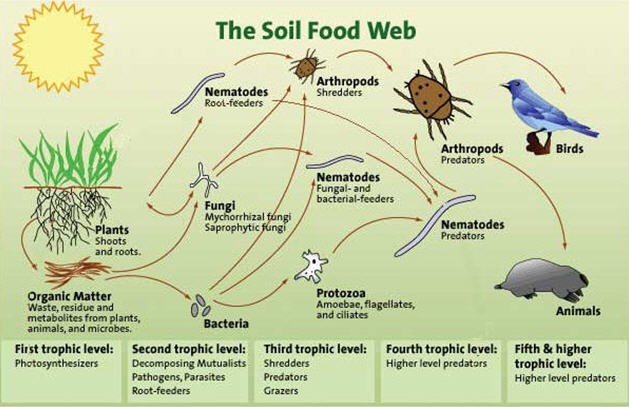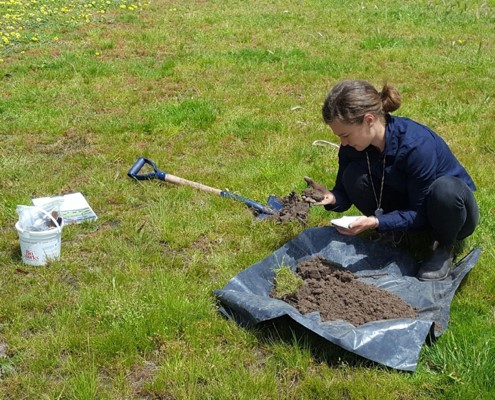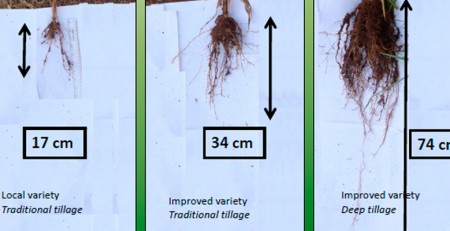Santé du sol – Bien plus qu’un simple test de sol
Dans le passé, nous avons écrit divers articles sur les sols. Comment ils sont formés; les régions climatiques et leurs effets sur les sols; texture du sol; les nutriments du sol; et plus. Au cours des dernières décennies, alors que l’agriculture s’oriente davantage vers des systèmes durables et s’éloigne de la prise de décision strictement basée sur les produits chimiques; Nous avons constaté que les chercheurs et les consultants ont élargi leurs mesures de la qualité du sol.
Un grand nombre des paramètres qui entrent en jeu pour la qualité des sols ont été intégrés entre une analyse chimique rigoureuse et des observations que l’agriculteur ou son conseiller sur le terrain pourraient noter et, dans de nombreux cas, ont bien servi l’industrie.
De nos jours, nous utilisons plus universellement le terme «santé du sol»; qui englobe plusieurs facteurs et tente de parvenir à une conclusion relative à l’état général d’un sol.
De nombreux laboratoires sont passés complètement à un «test biologique» des sols; plutôt que d’extraire simplement les nutriments disponibles dans un échantillon donné. Cette méthode examine la microbiologie dans un sol et détermine dans quelle mesure ce sol peut fournir des nutriments à la culture en croissance. Manipulation de l’échantillon procédures d’analyse; et le temps le font tous seuls, une manière très lourde d’évaluer vos sols.

Soil Biology is a key indicator of soil health. It should be evaluated with just as much importance as fertility and fertilizers. Source: Incorporating Soil Biology into Soil Health Assessment – Rutgers University
More and more laboratories are using what’s called a ‘Soil Health Assessment’ of quality, nutrient capacity, and crop nutrition capability. It is a far more comprehensive analysis of a given sample and can be quite useful to the farmer. Typically higher in cost, it might best be used to analyze soils of new fields, or fields that are problematic on a farm; with more regular testing at the lower cost analysis of nutrients alone.
Perhaps one way to look at a Soil Health Test might be like your annual ‘checkup’ or complete ‘physical’ your doctor recommends; except think of it more in longer terms than your doctor might..say, to do a soil health test on selected fields every, say, five years, rather than every year.
The primary components of a complete Soil Health Test are termed ‘Indicators’. They categorize measurements into four primary groups of measurable factors and include :
1. Soil organic matter – knowing your soil’s organic matter content helps your knowledge relative to nutrient retention; general soil fertility; soil structure; soil stability; and soil erosion potential. Too much organic matter can create nutrient availability issues, availability of plant protection materials like herbicides (mostly), insecticides (selected soil-applied insecticides), and fungicides (selected soil-applied systemics). Too little organic matter results in reduced nutrient holding, water holding, and nutrient availability problems since the soil cannot hold nutrients well in a sandy soil environment; and holds additional nutrients applied too tightly in a clayey soil environment.
2.Physical: measurements of the physical qualities of a soil relate to bulk density, infiltration, soil structure and macropores, soil depth, and water holding capacity. These assessments speak to factors like retention and transport of water and nutrients; habitat for soil microbes; estimate of crop productivity potential; compaction, plow pan, water movement; porosity; and workability. Look at these measurements as the ‘foundation’ of agricultural soil productivity. Having a soil whose physical characteristics are damaged or limited makes everything you do with that soil more challenging.
3. Chemical: this is the value of a Soil Nutrient Analysis from a lab, or what we generally call a ‘soil test’. It measures electrical conductivity, reactive carbon, soil nitrate, soil pH, and extractable phosphorus and potassium. Using extractants in a soil lab, you receive a quantitative and relative measurement of nutrient concentrations and their availability to crop production. They help to provide biological and chemical activity thresholds; plant and microbial activity thresholds; and plant available nutrients; as well as the potential for N and P loss when combined with the other indicators.
4. Biological: measuring and analyzing things like earthworm health and populations, microbial biomass Carbon and Nitrogen, particulate organic matter, potentially mineralizable N, soil enzymes, soil respiration, and total organic carbon allow the analysis to be more reliable. These considerations can also assist the farmer or his advisor to determine a long-term health assessment of a soil. Things like microbial catalytic potential and sites within the soil to retain Carbon and Nitrogen; soil productivity and Nitrogen supplying potential; and microbial activity measurements all come together with this aspect of Soil Health Analysis.
While all these ‘Indicators’ have always been evaluated in one way or another over centuries, Agricultural Researchers and Scientists are continually fine-tuning the methods with which they evaluate each of them; but more importantly, how to integrate them into a more complete assessment of your soil’s health.
The USDA-Natural Resource and Conservation Service (NRCS) has an excellent website where you can learn more about their agency’s field staff conduct a Soil Health Assessment using these indicators. Other labs across the world might have slightly different approaches, but they all share the goal to do as complete an analysis as possible to achieve Sustainability, Cost Efficiency, and Crop Yield Potential.
Read more about it:
USDA-NRCS: Soil Health Indices (pdf series of each indicator)
USDA- Guidelines for Assessing Soil Quality in Conservation Planning
Comprehensive Assessment of Soil Health – Complete Training Manual – Cornell University
Comprehensive Assessment of Soil Health – Cornell University – Soil Health Section
Main Image Credit: Incorporating Soil Biology into Soil Health Assessment – Rutgers University

Cornell University has compiled an excellent training manual for assessing Soil Health for Farmers and Advisors working with them. Source: Comprehensive Assessment of Soil Health – Complete Training Manual – Cornell University












